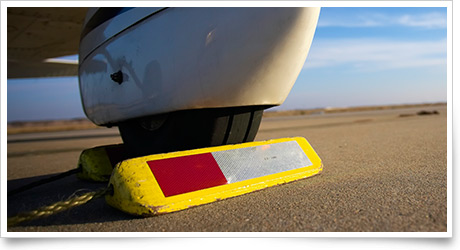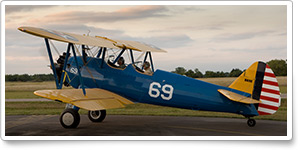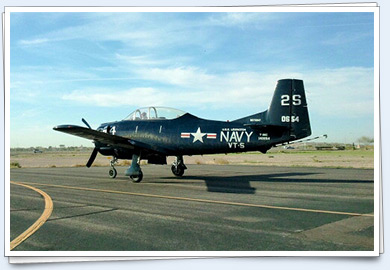May 3, 2013, issue of 'AOPA ePilot: Flight Training Edition' weekly newsletter
|
||||||
|
Back in a flash |
|
|||||
Training TipsBack in a flash
How fortuitous: Your parking spot on the ramp is closer to that end. You clear the area, start the engine, and add a touch of power to get you rolling slowly forward on the ramp, which is active with other aircraft in motion, and people walking up and down the line.
You don’t seem to be rolling yet, so you add a little more power, then a bit more. Now your engine is putting out enough horsepower (and noise) that people are looking in your direction.
What in the world?
That’s when you look out your side window and notice that the wheel chocks that had been lying there earlier are gone. Care to guess where they are?
There’s no escaping the realization that you must shut down the engine, get out, and remove the wheel chocks—those brightly painted yellow wheel chocks—from the nosewheel. At least you wisely quit while you were ahead and didn’t keep adding power until the aircraft jumped the chocks hazardously.
What’s the larger lesson? Any time you leave your aircraft unsupervised, give it your usual walk-around inspection on returning. Look it over for oil or brake fluid leakage, or any external damage. Was it grazed by another aircraft or a ground vehicle in your absence?
As the change in the runway in use shows, things happen fast at an airport. Going inside the FBO for a hot dog and a weather briefing may not take long, but outside, activity continues. Sometimes you may even come out and find that your aircraft has been relocated so the line crew can make room on the ramp for a larger aircraft, or to tow the company charter aircraft out of the main hangar. As a courtesy, the line crew likely will chock your wheels.
Bottom line: Whenever you return to an unattended aircraft, ask yourself, “What could have happened out here while I was gone?” Then inspect the ship carefully before you (attempt to) depart. Flight Training NewsPilot, 20, readies bid to become youngest ‘earthrounder’The aircraft’s annual inspection is complete. The immersion suit arrived on time, and a 20-year-old pilot from Fresno, Calif., has departed on a bid to become the Guinness World Records’ youngest person to fly around the world solo. Jack Wiegand, a business major at the University of Colorado in Boulder, plans to fly his family’s Mooney Ovation2 GX on a 50-day, 21,000-mile flight, making 24 stops in 14 countries (and crossing three oceans). Read more >> Chat about flying in Alaska on May 7Have you ever dreamed of flying in wild Alaska? Many pilots put this state on their aviation bucket list. Join Flight Training Editor Ian J. Twombly and Technical Editor Jill W. Tallman on Tuesday, May 7, at 3 p.m. Eastern for the monthly Flight Training Facebook chat. The guest chatter will be Kathy Dondzila, who flew with bush pilots above the Arctic Circle. Go to the Web page to set an email reminder. Florida Tech announces new Ph.D. in aviation sciencesA new program offering a Ph.D. in aviation sciences will be launched in the fall of 2013 at the Florida Institute of Technology College of Aeronautics in Melbourne. The program’s areas of specialization include aviation human factors, aviation safety, airport development and management, education and training, organizational development, operations research, environmental/sustainability, and meteorology. Read more >> American Bonanza Society unveils flight instructor academyThe American Bonanza Society and the ABS Air Safety Foundation have unveiled the ABS Flight Instructor Academy. The new program was created to help improve the performance, confidence, and safety of all Beechcraft pilots. The goal is to ensure that all Beech Bonanza, Debonair, Baron, and Travel Air pilots have access to safe, type-knowledgeable flight instructors for local training, as well as in ABS’ popular Beechcraft Pilot Proficiency Program (BPPP) Online+Flight and BPPP LIVE programs. NASTAR releases dates for summer campThe National Aerospace Training and Research Center (NASTAR) hosts a summer space camp for students in grades 2 to 12 in Southampton, Pa. The programs engage students in interactive activities designed to reinforce state standards for science, technology, engineering, and math (STEM) education, the NASTAR Center said. “Students are immersed in topics ranging from spaceflight to renewable energy.” The program for older students offers analytical, hands-on activities for those interested in careers in engineering, physics, and math. Younger students may participate in activities “that demonstrate the exciting side of learning and discovery.” Will you do the right thing when it counts?Nobody plans to have an accident. In fact, most accidents occur not because of clear-cut bad decisions, but because of a lot of small, questionable decisions that insidiously add up. The sum total of these decisions, however, usually ends with the pilot as a major topic of an NTSB accident report. Learn more and put your decision-making skills to the test with the Air Safety Institute’s Do the Right Thing: Decision Making for Pilots online course. Will you do the right thing? Log in to take the course >> Stretching your wingsLike people, aircraft need regular exercise to stay in shape. But the cold and darkness of winter mean that many airplanes sit idle for months at a time on the ramp or in their hangars, and bad things often happen to pilots who just unlock the doors, start the engine, and take off on the first VFR day of the year. Be a smarter pilot: Check out these resources for tips on getting your airplane ready for the spring flying season. Visit the Air Safety Institute’s “Spring Preflight” Safety Spotlight. Read more >> ScholarshipsAble Flight awards 2013 flight training scholarshipsFive new Able Flight scholarship recipients will begin five weeks of intensive flight and ground training leading to a pilot certificate when they arrive at Purdue University on May 19. The program brings people with physical disabilities into aviation. Scholarship recipients this year include a Marine who lost both legs to an improvised explosive device, a woman with multiple sclerosis, a man who had polio as a child, a young man injured in a skydiving accident, and a man paralyzed in a trampoline accident as a teenager. All five now use wheelchairs and will train in Sky Arrow light sport aircraft adapted with hand controls. Two students earn EAA/Daher-Socata scholarshipsKalena Glover of Prescott, Ariz., and William McAleer of Birmingham, Ala., have been named recipients of this year’s EAA/Daher-Socata International Scholarships. Now in its seventh year, the scholarship awards each recipient a five-week internship at Daher-Socata’s Tarbes, France, facility, followed by a week at the EAA Air Academy in Oshkosh, Wis., where interns will help Socata during EAA AirVenture 2013. All travel, lodging, and work experience is included, as well as a side trip to the Airbus facility in Toulouse. Minden Soaring Club awards eight scholarshipsThe Minden Soaring Club awarded $1,000 scholarships to eight young pilots from northwestern Nevada to help them continue their glider flight training. The scholarships were publicly awarded as part of the club’s banquet and annual membership meeting. The scholarship recipients are Alex Garic of Minden, Grant Dunkelman of Gardnerville, Zach Fisher of Dayton, Daisy Tanner of Minden, Donovan Harrison of Reno, Emma Justis of Reno, Ashley Cale of Gardnerville, and Collin Justis of Reno. NATF awards two scholarshipsThe National Air Transportation Foundation (NATF) has announced the winners of its Dan L. Meisinger Sr. Memorial Learn to Fly Scholarship and its Pioneers of Flight Scholarship. Marcus Kaleb Phillips, a student at the University of Central Missouri in Warrensburg who is pursuing a degree to become a professional pilot, received the 2012 Dan L. Meisinger Sr. Memorial Learn to Fly Scholarship. Whitney Brouwer, a student at LeTourneau University in Longview, Texas, and David Peck, a student at the Moody Bible Institute in Spokane, Wash., received the 2012 Pioneers of Flight Scholarship. Brouwer, a pilot, also hopes to use a degree in aircraft systems with an electrical technology concentration “to combine knowledge and experiences that will assist in the design of easier avionics and cockpit displays,” the foundation said. Peck will use his mission aviation technology degree to join a team that provides humanitarian support to remote locations around the world. Whirly-Girls International unveils new scholarshipA new $6,000 annual scholarship from Erickson Air-Crane to the Whirly-Girls will fund a full external load/vertical reference course at Western Helicopters in Rialto, Calif. The course includes ground instruction and up to 6.5 hours of external load training in an MD500 helicopter. Whirly-Girls in good standing will be able to apply for the scholarship on Oct. 1. ICAS Foundation accepting 2013 scholarship applicationsThe International Council of Airshows Foundation has opened applications for aviation scholarships to help pilots, aircraft mechanics, performers, and flight instructors with their training needs. Scholarship amounts range from $1,500 up to $4,000. Applications are due by Dec. 31, and winners will be announced in January 2014. Training ResourcesTest your map-reading skillsBefore GPS, VORs, LORAN, and NDBs, there were paper maps. Pilots used to pick their way through the skies with only a chart showing some landmarks on the ground. Test your knowledge of sectional charts with this Air Safety Institute quiz.
Did you know that student pilots who join AOPA are three times more likely to complete their flight training? Membership includes unlimited access to aviation information by phone (800/USA-AOPA, weekdays from 8:30 a.m. to 8 p.m. Eastern time) or from Flight Training Online or AOPA Online. If you’re not already a member, join today and get the pilot’s edge. Login information is available online.
Private rocket blast-off; Indiana tax cutA tax break in Indiana means pilots flying into the state will notice a big change to their fuel bill: Find out why you could save as much as $150 per fill-up. Plus, SpaceShipTwo made its first rocket-powered flight, the next step toward commercial space travel. And Rod Machado explains why sometimes thermal shock is good for your engine. AOPA Live This Week, May 2. Career PilotDelta to upgrade MD-88, MD-90 avionicsDelta Air Lines will outfit its fleet of 182 MD-88 and MD-90 aircraft, as well as several flight simulators, with standardized, state-of-the-art glass cockpits and GPS navigation, the company announced. The enhanced avionics suite, developed by Innovative Solutions & Support Inc., will allow the aircraft to fly shorter flight paths and take advantage of continuous-descent, Required Navigation Performance approaches to reduce fuel consumption, carbon emissions, and noise levels—primary objectives of the FAA’s NextGen modernization initiative. Not only will the changes add GPS capabilities, datalink, and Automatic Dependent Surveillance-Broadcast, but the lighter weight of the new equipment will improve fuel economy. Standardized flight decks are expected to improve situational awareness for flight crews and increase operational flexibility, simplify maintenance, and improve dispatch reliability. Installation of the glass cockpits across the MD-88 and MD-90 fleet is slated to begin in early 2014 and will require approximately two years.
For more aviation career news, see the Flight Training website. Plane SpotterThe wings of spring: Stearman
Training ProductsKing Schools adds ATP written courseKing Schools has added an online version of the ATP/Part 121 Dispatcher Knowledge Test Course.The online course uses existing videos from King Schools’ DVD series, broken down into 10-minute clips that end with quizzes. Jeppesen offers the Private Pilot Ultimate KitJeppesen’s Private Pilot Kits, developed for both FAR Part 61 and FAR Part 141 training programs, offer complete private pilot training packages. Kit materials lead student pilots through essential aeronautical knowledge and expose them to interesting and useful information that will enhance and expand understanding of the world of aviation.
Note: Products listed have not been evaluated by ePilot editors unless otherwise noted. AOPA assumes no responsibility for products or services listed or for claims or actions by manufacturers or vendors. Member BenefitsThe shifting sands of medical certification policyThe FAA Office of Aerospace Medicine recently announced changes to several policies regarding certification of certain cardiac conditions. The FAA invests considerable staff time in reviewing the current medical literature and seeking input from their specialist consultants to establish appropriate evidence-based medical certification policy. However, it has been a while since the FAA has seen so much activity that will have a bearing on a number of different medical conditions, and as a result, will have a positive impact on a number of airmen who currently hold special issuance authorizations. Read more >> What is nonowned insurance and why should I have it?Nonowned insurance is a liability insurance policy to protect you against claims arising from bodily injury and property damage for which you are legally liable, caused by an occurrence arising from your use of a nonowned (rented or borrowed) aircraft. Even if the FBO tells you it has coverage, you’ll still need to protect yourself. Read more >> BlogsHandling a failed checkrideFor any training that you complete for certificates and ratings, you will be evaluated on a checkride. The ride represents the culmination of a lot of hard work on the part of both you and your instructor. People are often their own worst critics, and it must be part of a pilot’s DNA to get that characteristic in double doses. Whenever pilots get ready to take a checkride, it seems that they begin to develop a lot of doubt and concern about how prepared they are. Read more >> In-flight vibrationsWhen a critical component in a helicopter’s main rotor system fails in flight, the resulting accident is almost always fatal. How much warning, if any, does a pilot get with these kinds of failures? Unfortunately, the vast majority of helicopters do not have cockpit voice recorders and unless the pilot can provide ATC with details, it can be hard to understand exactly what happened. Read more >> New pilots and more safetyDave Hirschman, AOPA Pilot senior editor, and Bruce Landsberg, president of the AOPA Foundation, frequently commiserate on the high cost of flying. For too long the industry has tried to avoid the fact that new piston aircraft are priced above what most of the market can afford. There’s a saying that goes, “It isn’t what you pay, it’s what you get that equals value.” Read more >> AOPA Career OpportunitiesEver dream of turning your passion for aviation into a career? We’re looking for a human resources assistant, software test and quality assurance analyst, online marketing and content specialist, AOPA Live editor/graphic artist, advertising marketing manager, mid-level gift specialist, aviation technical specialist, staff assistant/PAC coordinator, president of AOPA Insurance Services, major gifts officer, and director of outreach and events. To learn more about other AOPA career opportunities, visit AOPA Online. Community
AVIATION EVENTS & WEATHER
|
||||||||||||||||||||||||||||||||||||




 You arrived at the first stop on your long cross-country within minutes of your estimated time of arrival. Now, as you prepare to head off on the second leg, fortified by a snack from the coffee shop and with
You arrived at the first stop on your long cross-country within minutes of your estimated time of arrival. Now, as you prepare to head off on the second leg, fortified by a snack from the coffee shop and with 



